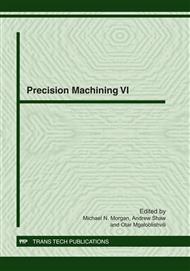p.132
p.138
p.144
p.150
p.156
p.162
p.168
p.176
p.182
An Investigation on Improved Theoretical Modelling for Surface Generation in Nanometric Cutting
Abstract:
In this paper, the existing models micro/nanometric cutting mechanics and physics are critically reviewed including ductile mode cutting models, cutting forces models and surface generation models. A comparison study is carried out each aspect of the three groups of models being considered. The combination and formulation of these models into one integrated model is to be performed in order to accrue benefits arising from the advantages of each model. This paper concludes with further discussion on the concepts for the improved modelling and possible development of new models.
Info:
Periodical:
Pages:
156-161
Citation:
Online since:
December 2011
Authors:
Price:
Сopyright:
© 2012 Trans Tech Publications Ltd. All Rights Reserved
Share:
Citation:


